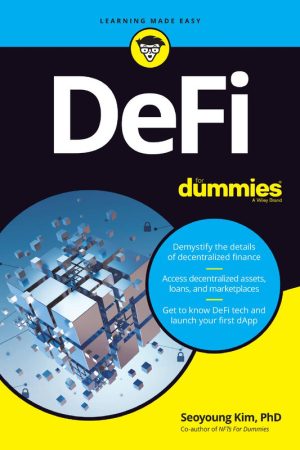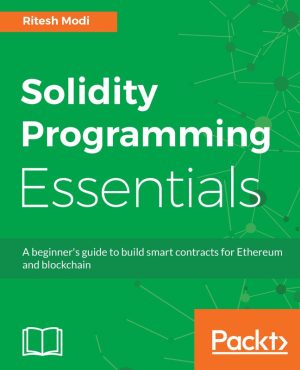Description
Price: 25.00 USD | Size: 16.8 GB | Duration : 39.35 Hours | 380 Video Lessons |
BRAND: Expert TRAINING | ENGLISH | INSTANT DOWNLOAD | 
Smart Contract Hacking
Master the Most Demanded
Skill in the industry 🚀
STAND OUT ON THE JOB MARKET
HIGH SALARY
Junior Smart Contract Auditor: $50-$100/h
Senior Smart Contract Auditor: $300-$500/h
Become a part of a small highly-qualified professional pool and make headhunters go crazy about you.
GAIN EXCLUSIVE ACUMEN
Practical Course
All-in-one go-to resource packed with
🎞️ 320+ videos / ⏱️ 30+ hours / 👨💻 40+ exercises.
High-quality content for you to build your skills. Have fun learning meanwhile accelerating your career and getting infinite opportunities.
# Smart Contract Hacking – Part 1
01. Introduction
1. Welcome
2. Who is this for
3. What is in it for you
4. Course Contents
5. Career Shift
6. The Exercises
7. Social Media Presence
8. Copyright
02. Career Paths
1. Agenda
2. Auditing Firms
3. Private Audits and DAOs
4. Bug Bounties
5. Auditing Contests
6. Hands-On Time
03. DEV Tools
1. Agenda
2. Our IDE
3. Hello Hardhat
4. Hardhat Commands
5. Metamask
6. Summary
04. Intro to the EVM
01. Agenda
02. Ethereum
03. Accounts in Ethereum
04. Transactions in Ethereum
05. EVM Components
06. Global Variables
07. Persistent Data
08. Volatile Data
09. Transaction Lifecycle
10. Smart Contract Calls
11. Summary
05. Excersise Guideline
1. Exercise Guidelines
1.1 sch-lite-exercises-main
1.2 sch-lite-solutions-main
06. Tokens Crash Course – Fungible Tokens
01. Agenda
02. What are fungible tokens
03. ERC20 standard
04. ERC20.sol Deep Dive
05. Built-in Functions
06. Extensions
07. Summary
08. Exercise 1 – Instructions
09. Exercise 1 – Solution
10. Exercise 2 – Instructions
11. Exercise 2 – Solution
07. Tokens Crash Course – Non-Fungible Tokens
01. Agenda
02. NFTs
03. ERC721 Standard
04. ERC721.sol
05. Built-in Functions
06. Extensions
07. Summary
08. Exercise 1 – Instructions
09. Exercise 1 – Solution
10. Exercise 2 – Instructions
11. Exercise 2 – Solution
08. Randomness Vulnerabilities
01. Agenda
02. Randomness Use Cases
03. The Problem
04. Example
05. The Solution
06. Summary
07. Exercise 1 – Instructions
08. Exercise 1 – Solution
09. Exercise 2 – Instructions
10. Exercise 2 – Solution
09. Arithmetic Overflows and Underflows
01. Agenda
02. Integers in Solidity
03. Overflows and Underflows Explained
04. Examples
05. Why is it Dangerous
06. Avoiding Overflows and Underflows
07. Summary
08. Exercise 1 – Instructions
09. Exercise 1 – Solution
10. Exercise 2 – Instructions
11. Exercise 2 – Solution
12. Exercise 3 – Instructions
13. Exercise 3 – Solution
14. Exercise 4 – Instructions
15. Exercise 4 – Solution
10. Phishing Attacks
1. Agenda
2. Wha are Phishing Attacks
3. Web2 Phishing Examples
4. Web3 Phishing Examples
5. Phishing with tx.origin
6. Summary
7. Exercise 1 – Instructions
8. Exercise 1 – Solution
11. Reentrancy Attacks
01. Agenda
02. Accounts in Ethereum
03. How Contracts Receive ETH
04. Reentrancy Explained
05. Simple Reentrancy
06. Advanced Reentrancy
07. Mitigating Reentrancy Attacks
08. Summary
09. Exercise 1 – Instructions
10. Exercise 1 – Solution
11. Exercise 2 – Instructions
12. Exercise 2 – Solution
13. Exercise 3 – Instructions
14. Exercise 3 – Solution
15. Exercise 4 – Instructions
16. Exercise 4 – Solution
12. Access Control Vulnerabilities
01. Agenda
02. Functions Visibility
03. Variables Visibility
04. Developers Make Mistakes
05. Default Visibility Vulnerabilities
06. Access Control Vulnerabilities
07. Mitigating Access Control Vulnerabilities
08. Access Control by OpenZeppelin
09. Summary
10. Exercise 1 – Instructions
11. Exercise 1 – Solution
12. Exercise 2 – Instructions
13. Exercise 2 – Solution
14. Exercise 3 – Instructions
15. Exercise 3 – Solution
16. Exercise 4 – Instructions
17. Exercise 4 – Solution
# Smart Contract Hacking – Part 2
01. DEFI Crash Course – Decentralized Exchanges
01. Intro
02. What are DEXes
03. DEXes Advantages
04. How DEXes Work
05. DEX Example – Uniswap
06. Automated Market Maker
07. Uniswap Architecture
08. Uniswap Contracts Factory.sol
09. Uniswap Contracts Router.sol
10. Uniswap Contracts Pair.sol
11. Summary
12. Exercise 1 – Instructions
13. Exercise 1 – Solution
14. Exercise 2 – Instructions
15. Exercise 2 – Solution
02. DEFI Crash Course – Money Markets
01. Intro
02. Traditional Lending and Borrowing
03. What are Money Markets
04. Glossary
05. AAVE Overview
06. AAVE V3 Contracts Receipt Tokens
07. AAVE V3 Contracts Debt Tokens
08. AAVE V3 Contracts Pool.sol
09. AAVE Demo
10. Compound Overview
11. Compound Architecture and Contracts
12. Compound V2 Contracts cToken.sol
13. Compound V2 Contracts Comptroller.sol
14. Compound Demo
15. Guess the Fork
16. Summary
17. Exercise 1 – Instructions
18. Exercise 1 – Solution
19. Exercise 2 – Instructions
20. Exercise 2 – Solution
03. Replay Attacks
01. Intro
02. Symmetric Encryption
03. Asymmetric Encryption
04. Asymmetric Signing
05. How Crypto Wallets Work
06. Signing and Verifying Transactions
07. What Can We Sign
08. Signing and Verifying Data
09. Replay Attack Explained
10. Preventing Replay Attacks
11. EIP712 and ERC20 Permit
12. Summary
13. Exercise 1 – Instructions
14. Exercise 1 – Solution
15. Exercise 2 – Instructions
16. Exercise 2 – Solution
17. Exercise 3 – Instructions
18. Exercise 3 – Solution
04. Flash Loans and Flash Swaps
01. Intro
02. Reminder – Money Markets
03. What Are Flash Loans
04. How Flash Loans Work
05. AAVE V3 Flash Loan
06. Reminder – Uniswap V2
07. Uniswap V2 Flash Setup
08. Summary
09. Exercise 1 – Instructions
10. Exercise 1 – Solution
11. Exercise 2 – Instructions
12. Exercise 2 – Solution
13. Exercise 3 – Instructions
14. Exercise 3 – Solution
05. Flash Loan Attacks
01. Intro
02. Reminder – Flash Loans
03. What Are Flash Loan Attacks
04. Exploiting Protocols Using Flash Loans
05. Preventing Flash Loan Attacks
06. Summary
07. Exercise Notes
08. Exercise 1 – Instructions
09. Exercise 1 – Solution
10. Exercise 2 – Instructions
11. Exercise 2 – Solution
06. DoS Attacks
01. Intro
02. What is Denial of Service
03. DoS vs DDoS
04. Smart Contract DoS Attack
05. Dependent on Owner
06. Dependent on External Call
07. Dependent on External Data
08. DoS Using Gas Manipulations
09. Preventing DoS Attacks
10. Summary
11. Exercise 1 – Instructions
12. Exercise 1 – Solution
13. Exercise 2 – Instructions
14. Exercise 2 – Solution
15. Exercise 3 – Instructions
16. Exercise 3 – Solution
17. Exercise 4 – Instructions
18. Exercise 4 – Solution
07. Sensitive On-Chain Data
01. Intro
02. All Blockchain Data is Public
03. EVM Storage Deep Dive
04. EVM Storage Challenge
05. On-Chain Examples
06. Transactions Analysis
07. Hello. CAST
08. Summary
09. Exercise 1 – Instructions
10. Exercise 1 – Solution
11. Exercise 2 – Instructions
12. Exercise 2 – Solution
13. Exercise 3 – Instructions
14. Exercise 3 – Solution
08. Unchecked Returns
01. Intro
02. Reminder – Smart Contract Calls
03. The Problem
04. High-Level Calls
05. High-Level Internal Calls
06. transfer() Opcode
07. High-Level External Calls
08. SafeERC20
09. Low-Level Calls
10. send() Opcode
11. call() Opcode
12. High-Level vs Low-Level Calls
13. Summary
14. Exercise 1 – Instructions
15. Exercise 1 – Solution
16. Exercise 2 – Instructions
17. Exercise 2 – Solution
18. Exercise 3 – Instructions
19. Exercise 3 – Solution
09. Frontrunning
01. Intro
02. Frontrunning Explained
03. Frontrunning in Web3
04. Mempool Explained
05. Bots are Everywhere
06. Why is Frontrunning Important
07. Frontrunning Examples
08. Sandwich Attack Explained
09. Vulnerable Contracts
10. Summary
11. Exercise Notes
12. Exercise 1 – Instructions
13. Exercise 1 – Solution
14. Exercise 2 – Instructions
15. Exercise 2 – Solution
16. Exercise 3 – Instructions
17. Exercise 3 – Solution
10. DAO and Governance Attacks
01. Intro
02. DAO Explained
03. DAO Assets
04. DAO Operations
05. DAO Examples – Nouns DAO
06. DAO Examples – Illuvium DAO
07. DAO Examples – PancakeSwap DAO
08. DAO Examples – Olympus DAO
09. Attacking DAOs
10. Summary
11. Beanstalk Hack Case Study
12. Exercise 1 – Instructions
13. Exercise 1 – Solution
14. Exercise 2 – Instructions
15. Exercise 2 – Solution
16. Exercise 3 – Instructions
17. Exercise 3 – Solution
11. Oracle Manipulation
01. Intro
02. The Need for Oracles
03. What is an Oracle
04. Oracles Use Cases
05. Synthetic Assets
06. Lending Protocols
07. Maker DAO
08. Oracle Types
09. Off-Chain Centralized Oracles
10. Off-Chain Decentralized Oracles – Chainlink
11. Off-Chain Oracles
12. Exploiting On-Chain Oracles
13. Uniswap TWAP
14. Oracles Attack Bectors
15. Synthetix Case Study
16. Best Practices
17. Summary
18. Exercise 1 – Instructions
19. Exercise 1 – Solution
20. Exercise 2 – Instructions
21. Exercise 2 – Solution
22. Exercise 3 – Instructions
23. Exercise 3 – Solution
12. Call Attacks
01. Intro
02. call() Opcode
03. call() Usecases
04. Call Attacks
05. delegatecall() Opcode
06. delegatecall() Usecases
07. Proxy Contracts
08. Clones and Minimal Proxies
09. Upgradeable Proxies
10. Proxies Issues
11. Storage Collisions
12. Summary
13. Exercise 1 – Instructions
14. Exercise 1 – Solution
15. Exercise 2 – Instructions
16. Exercise 2 – Solution
17. Exercise 3 – Instructions
18. Exercise 3 – Solution
19. Exercise 4 – Instructions
20. Exercise 4 – Solution
13. Auditing Methodology by Trust
1. What Defines a Good Auditor
2. Top Level Overview
3. The Invisible State Machine
4. Auditing Approach
5. Differential Auditing
6. Soft Spots
7. Off Keyboard Methodology
8. How to Improve
14. Auditing DAOs 101 by Pashov
1. Intro
2. What is Oak Security
3. What is Spearbit DAO
4. How to Crush the Interview
5. Insider Tips
6. How to Get Promoted
15. Transitioning to Web3 Security by Owen
1. Intro
2. Have a Goal Set
3. Deal With the Pain Now
4. Track Your Work Religiously
5. Join a Community
6. Live Below Your Means
7. Summary
16. How to Crush Auditing Contents by Trust
1. Intro
2. Payout Scheme
3. Auditing Contests – Advantages and Disadvantages
4. How to Improve Quickly
5. Code4rena Judge Inside Tips
6. Dos and Dont’s
7. How to Top the Leaderboard
8. Making the Most of Backstage
9. Know your Competition
17. Get Fully Booked as a Private Auditor by Pashov
1. Intro
2. What is Private Auditing
3. Marketing and Branding
4. Sales
5. Providing the Best Service
6. Required Technical Skills
7. End Result
18. Yield Optimizers by Owen
01. Intro
02. What are Yield Optimizers
03. Beefy Finance Explained
04. How Does Auto Compound Happen
05. The Vault Code
06. The Withdrawal Fee
07. Vault Attack Example
08. Exercises Instructions
09. Exercise 1 – Solution
10. Exercise 2 – Solution
19. Advanced Gas Griefing Attacks by Owen
1. Intro
2. 63 or 64 Rule
3. What is Gas Griefing
4. Optimism Contest Vulnerability Example
5. Having a Gas Limit
6. Exercise 1 – Instructions
7. Exercise 1 – Solution
Discover more from Expert Training
Subscribe to get the latest posts sent to your email.
























Reviews
There are no reviews yet.